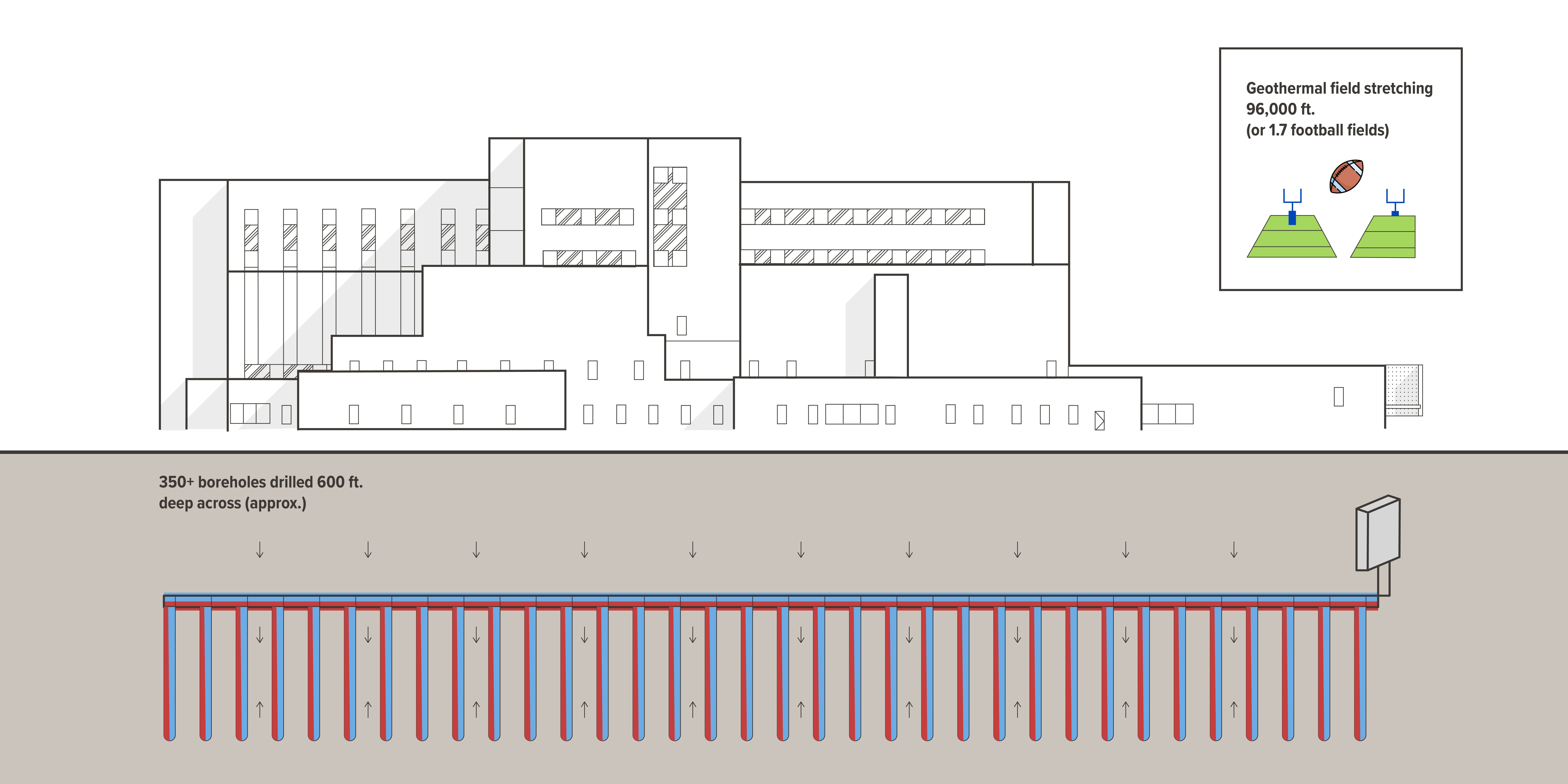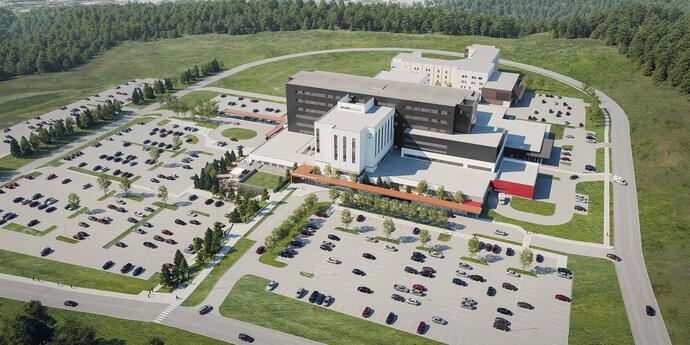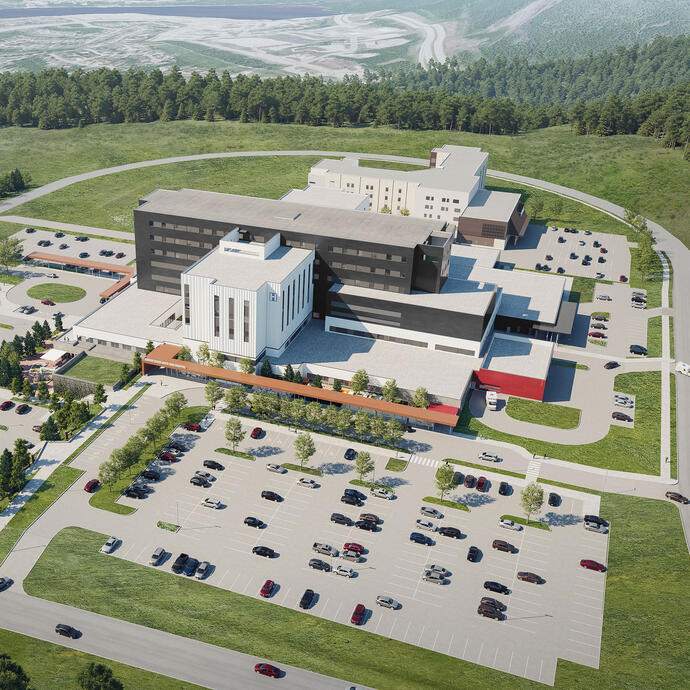For the New Western Memorial Regional Hospital, you have to look below the new seven-storey, 600,000 square foot acute care centre to find the answer…


The Challenge.
The Government of Newfoundland and Labrador selected Corner Brook Health Partnership as the Public Private Partnership project team to build the New Western Memorial Regional Hospital (formerly known as the Corner Brook Acute Care Hospital). From the outset, the partnership sought to enhance the healthcare services of western Newfoundland and southern Labrador residents with cost-effective solutions that positively-affect the surrounding environment. This objective placed a heavy emphasis on long-term, sustainable design solutions and targets (such as LEED Silver), particularly when it came to the facility’s heating and cooling.
Due to the lack of available natural gas in Newfoundland and Labrador, traditional heating and cooling systems (such as fuel oil-fired boilers) would be the go-to option for this type of facility. However, those traditional solutions are associated with significant GHG emissions—the exact opposite of the project team’s objectives.
By combining the limitations of natural gas with the priority of a sustainable and cost-effective solution, the Smith + Andersen mechanical team unearthed the ideal low-energy and low-emission solution for heating and cooling at New Western Memorial Regional Hospital: a geothermal system.
The Solution.
A geothermal system offers an eco-friendly approach to building heating and cooling, utilizing the ground, as well as any natural subterranean water movement, as a heat source or sink. By pumping an anti-freeze water solution through buried pipe loops, geothermal fields transfer heat to and from the ground to create cooling and heating through the refrigeration cycle, reducing annual building energy consumption through the storage and re-use of the building’s wasted heat through the geothermal field. Located beneath the hospital’s parking lot, the field requires approximately 375 boreholes drilled 600 feet deep for approximately half a million linear feet of piping.
As the primary heating and cooling system utilized for the acute care hospital, the geothermal system will reduce the annual heating energy consumption and eliminates the use of fossil fuels. This system will also reduce the visual and acoustic impacts of heating and cooling to the facility, as roof-mounted cooling towers and chillers are eliminated. Additionally, the system will improve system maintainability by consolidating all equipment into a single mechanical room—integrating the heating and cooling system using the same source equipment and reducing the requirement for additional boilers due to the effectiveness of the geothermal system.
To put this proposed geothermal solution into action, the Smith + Andersen national healthcare team is coordinating with the P3 project delivery team. The success of the geothermal system relies on accurate information shared among the design and construction team to develop an accurate energy model, which in turn influences the operation of the mechanical systems, lighting and equipment, and the construction of the building envelope.
To facilitate the symbiotic relationship between the hospital and the geothermal field, our team has proposed supplementary heating from the building’s electric steam boilers. In Newfoundland and Labrador, most geothermal sites are heating dominated, which could lead to the facility absorbing more heat from the ground than what the facility is returning. Providing a supplementary electric option allows the geothermal field to naturally replenish—maintaining the field’s ability to meet demand over the lifecycle of the building by finding the balance between too hot or too cold.
This proposed geothermal system is the largest geothermal field in Canada servicing a healthcare facility, and the second largest geothermal system utilized for any building nation-wide.
The Result.
When the New Western Memorial Regional Hospital is completed in 2023, the incorporated geothermal system will result in a significant reduction in consumption, demand, and operating costs associated with heating and cooling the building. While a higher capital cost is associated with the construction of the geothermal field, the result will be a system culminating in significant financial savings over the complete lifecycle of the hospital. The facility achieved a 17-year simple payback period based on current electricity costs, with the true payback period anticipated to improve over the lifecycle of the facility due to rising energy costs.
The energy modelling team—Footprint—projected approximately 35 per cent energy cost savings as compared to the ASHRAE 90.1-2010 baseline model. This will result in 14 LEED points from energy savings alone, contributing to the LEED Silver target.
In addition, the proposed geothermal system offers long-term opportunities as an electrical heating source—a solution that is ideal for provinces such as Newfoundland and Labrador, which is primarily hydro-powered. In concert with the province of Newfoundland and Labrador’s The Way Forward on Climate Change GHG reduction targets by 2030, when the electrical grid serving the New Western Memorial Regional Hospital is upgraded to produce zero-emissions, the facility’s entire heating and cooling solution will similarly produce zero-emissions.
The New Western Memorial Regional Hospital will not only deliver enhanced healthcare services for Newfoundland and Labrador residents. Through the use of a geothermal heating and cooling system, the facility will also stand as an example of sustainable design positively impacting healthcare for decades to come.









